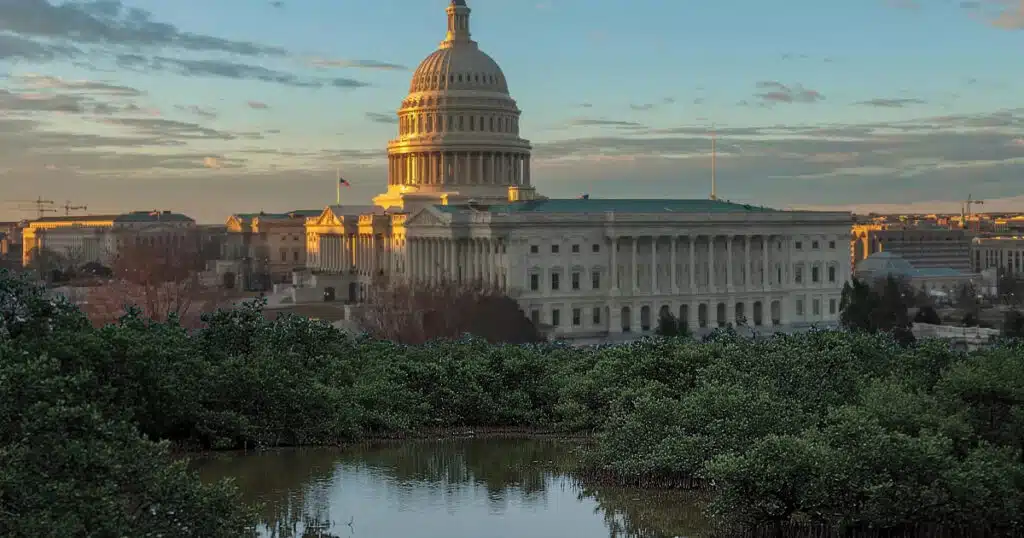
Who Counts? Trump Poised To Try To Remove Noncitizens From Census
Following a years-long surge in illegal immigration, the Trump administration is poised to challenge a longstanding but legally fraught practice: counting illegal aliens in the U.S. census.
President Trump tried to end the practice during his first term, but President Biden overturned his predecessor’s policy before it was implemented. Now, buoyed by red state attorneys general and Republican legislators, the second Trump administration is determined “to clean up the census and make sure that illegal aliens are not counted,” White House Deputy Chief of Staff for Policy Stephen Miller said last month.
What Miller didn’t mention are the political implications of the administration’s move. It could have significant political implications because the census count is used to apportion House seats, determine the number of votes each state gets in the Electoral College for selecting the president, and drive the flow of trillions of dollars in government funds.
Some immigration researchers project that including noncitizens in the census count disproportionately benefits Democratic states with large illegal alien populations. A recent study counters that, based on 2020 census figures, there would have been a negligible shift to the political map had the U.S. government excluded noncitizens from that count. But looking backward, those researchers found, red states would have benefited under the administration’s desired census counting shift. Had authorities excluded such migrants from the 2010 census, Louisiana, Missouri, Montana, Ohio and North Carolina all would have gained one seat in the House, while California would have lost three seats, and Texas and Florida would have each lost one seat – with the total number of Electoral College votes allotted each state changing accordingly.
Since the first census in 1790, the nation has counted not only citizens but also residents to determine such representation. In addition to citing its long history, defenders of the practice say it is only fair that states should be given the power and resources to represent and serve everyone within their borders.
Critics contend the government’s powers come from “We the people” – citizens or eligible voters – a government established before tens of millions of migrants resided in the country illegally. They also say the practice dilutes the representation of American citizens while incentivizing localities to promote illegal immigration.
Trump’s first term hints at what is to come if his administration vigorously pursues a citizen-centric census policy. In July 2020, when the president issued a memorandum to exclude illegal migrants from the census, blue states and immigration groups challenged it in court almost immediately.
Those challenges rose all the way to the Supreme Court. But it did not rule on the merits – whether all residents must be counted and if the president has the authority to exclude nonresidents – setting the stage for a battle over immigration and presidential power.
The Meaning of the 14th Amendment
The census issue hinges on the Constitution’s language, which calls for apportioning House seats among the states “according to their respective Numbers.” Those “Numbers” originally included “free Persons” and “three-fifths of all other Persons” – namely slaves, a result of the states’ compromise. The framers excluded “Indians not taxed” – Native Americans who were members of sovereign tribal nations, not citizens – from the count.
After the Civil War, Congress passed the 14th Amendment to recognize the rights of the formerly enslaved. It states that congressional representation “shall be apportioned among the several States according to their respective numbers, counting the whole number of persons in each State,” again excluding Indians not taxed. Under the Indian Citizenship Act of 1924, this population would be granted citizenship.
Congress tasked the secretary of commerce with carrying out the census “in such form and content as he may determine.” The president receives that data, is responsible for carrying out the apportionment calculations, and transmits the information to Congress.
Echoing arguments against birthright citizenship, critics on the right say that the 14th Amendment aimed to address the status of former slaves, not masses of illegal migrants. They assert that including this population in the census artificially skews political power, effectively disenfranchises citizens, and incentivizes states to adopt sanctuary policies protecting people here illegally.
“…[R]espect for the law and protection of the integrity of the democratic process warrant the exclusion of illegal aliens from the apportionment base, to the extent feasible and to the maximum extent of the President’s discretion under the law,” President Trump wrote in the 2020 memorandum.
The first Trump administration argued that the “persons in each State” that the 14th Amendment refers to had long been interpreted to mean “inhabitants.” Inhabitants, it asserted, do not include “every individual physically present within a State’s boundaries at the time of the census,” noting that past administrations had excluded temporary aliens and foreign diplomatic personnel for apportionment.
The administration also argued that the Constitution and relevant law authorize the executive branch to determine who is to be counted as an inhabitant in the census. The president, therefore, had discretion to omit “persons with debatable ties to a State,” like “aliens living within a jurisdiction without the sovereign’s permission to settle there.”
The administration pointed to Franklin v. Massachusetts to support its claims.There, the Supreme Court held that the President George H.W. Bush administration could include Defense Department employees deployed overseas in the census. Then, the Court found that the president’s duties in the census process are not solely “ceremonial or ministerial,” and that federal law “does not curtail the President’s authority to direct the [Commerce] Secretary in making policy judgments that result in ‘the decennial census.’”
In testimony at the Democrat-led July 2020 House Oversight Committee hearing on the Trump memorandum, Republicans tabbed the head of the Claremont Institute’s Center for Constitutional Jurisprudence, John Eastman, to defend it. The conservative legal scholar, much-maligned by the left for the counsel he provided President Trump regarding challenging the 2020 election, recently told RealClearInvestigations that the Declaration of Independence’s “consent principle” – the concept that government derives its power from the American people – “compels that only citizens be counted for purposes of reapportionment,” and that the principle “is actually codified in the Constitution by excluding ‘Indians not taxed.’” In Eastman’s view, that language signifies that the founders sought to omit “those who are not part of our political community, from the apportionment for representation.”
“President Trump would be on solid ground, therefore, were he to direct that the census either not count illegal aliens at all, or at the very least record citizenship status so that a proper apportionment of citizens could be conducted,” Eastman said.
The plaintiffs challenging the Trump administration contended that the 14th Amendment’s “persons” includes all residents irrespective of their immigration status; that the president lacked the discretion to deem otherwise; and that the process the administration had put in place to exclude illegal aliens was legally deficient. The president had issued a July 2019 directive in advance of his memo instructing the Census Bureau to collect citizenship data from various federal agencies, which would have been used to exclude illegal aliens from the apportionment count, raising additional legal questions.
Testifying opposite Eastman at the committee hearing, former Census Bureau directors warned that the president’s memo would spook potential respondents and suggested the memo would minimally create the appearance of politicizing the census.
Trump’s action reflected an “illegal desire of only counting citizens,” said Vincent Barabba, former Census Bureau director under the Nixon, Ford, and Carter administrations. “[H]is real objective…is to make sure less people will be counted in states with large minority populations which did not support President Trump or the positions he has taken.”
When litigation over the Trump census policy reached the Supreme Court, it punted. In December 2020, the justices held by a 6-3 margin in Trump v. New York that the plaintiffs lacked standing, and that the case was not ripe for adjudication – with Justices Steven Breyer, Sonia Sotomayor, and Elena Kagan dissenting.
Upon taking office, President Biden issued a first-day executive order revoking both of Trump’s policies. Excluding people based on their immigration status “conflict[s] with the principle of equal representation enshrined in our Constitution, census statutes, and historical tradition,” Biden wrote. “Reapportionment shall be based on the total number of persons residing in the several States, without regard for immigration status.”
States Provide a Backup Plan
The first Trump administration lost a related case at the Supreme Court. In 2018, the administration reinstated a question on the decennial survey about the citizenship status of respondents – a move that likewise came under furious legal challenge.
The Commerce Department stated that it reinstated the question at the behest of the Justice Department, which was seeking superior data on voting-age citizens necessary to enforce the Voting Rights Act. Critics sued the administration, saying that including the question, which administrations had dropped after 1960, would chill immigrant respondents, leading to an unconstitutional undercount.
In June 2019, the justices found that while reinstating such a question was legal, the process by which the president sought to do so was invalid, since the Commerce Department’s rationale for including it was “contrived” and “pretextual” – in violation of the Administrative Procedure Act.
If the second Trump administration fails to win court approval of its expected effort to exclude illegal migrants, this time around, it will have backup.
Three days before Trump’s second inauguration, Louisiana, Kansas, Ohio, and West Virginia sued the Commerce Department, arguing that its prevailing practice of counting foreigners including illegal aliens at their place of “‘usual residence…’ robb[ed] the people of the Plaintiff States of their rightful share of political representation, while systematically redistributing political power to states with high numbers of illegal aliens and nonimmigrant aliens.”
They want the federal court, among other things, to vacate this “Residence Rule” to the extent it requires the Census Bureau to “include illegal aliens and nonimmigrant aliens in the apportionment base.” And they want to require the Census Bureau to include questions on the survey about citizenship, including one to determine whether non-citizen respondents are lawful permanent residents.
In March, the federal court stayed the case at the Trump administration’s request. The administration said it needed time “to determine its approach to the Residence Rule.” The White House and states plan to provide a joint status update on July 1.
The Justice and Commerce Departments did not respond to RCI’s requests for comment.
Republicans Seek a Legislative Fix
In the interim, Congress has acted. During the last session, Republican members introduced the Equal Representation Act, requiring the census to include a citizenship question and exclude all non-citizens from the census count for apportionment.
Democrats panned the bill, with the then-ranking member of the House Oversight Committee, Jamie Raskin, writing in a minority report that “The plain reading of the [constitutional] text is clear as day, and the original purposes have been carefully articulated and never rebutted. For those who like to follow precedent, every apportionment since 1790 has included every single person residing in the United States, not just those lucky enough to have been given the right to vote.”
In 2016, the Supreme Court held that a state or locality may draw legislative districts based on total population, irrespective of the fact that some districts may have significantly larger voter-eligible populations than others.
Writing for the majority, the late Justice Ruth Bader Ginsburg said that “we need not and do not resolve whether…States may draw districts to equalize voter-eligible population rather than total population.”
Fifty years prior, the Court held that Hawaii could use a registered-voter population base for its apportionment of state legislative seats due to the “large concentrations of military and other transients” in key population center Oahu.
In May 2024, the House passed the Equal Representation Act on a largely party-line vote, but it failed to advance in the Senate.
The current House reintroduced the bill by North Carolina Republican Rep. Chuck Edwards. He told RealClearInvestigations that “Americans deserve fair and equal representation, something that will not be possible until we eliminate the influence of noncitizens in our elections.”
The bill must first move through the Oversight Committee, chaired by Kentucky GOP Rep. James Comer. He told RCI that “American citizens’ representation in Congress should not be determined by individuals who are not citizens of the United States.”
Comer said his committee plans to move the bill again during this congressional session.
The states suing the Commerce Department are adamant that their view should prevail irrespective of legislative action.
Christopher Hajec, Director of Litigation at the Immigration Reform Law Institute – a legal nonprofit opposed to “unchecked mass migration” that is representing Kansas in the pending states’ suit – told RCI that “Whatever Congress does or does not do, our position is that the Constitution implies that illegal aliens should not be counted in the census for apportionment.”
This article was originally published by RealClearInvestigations and made available via RealClearWire.



